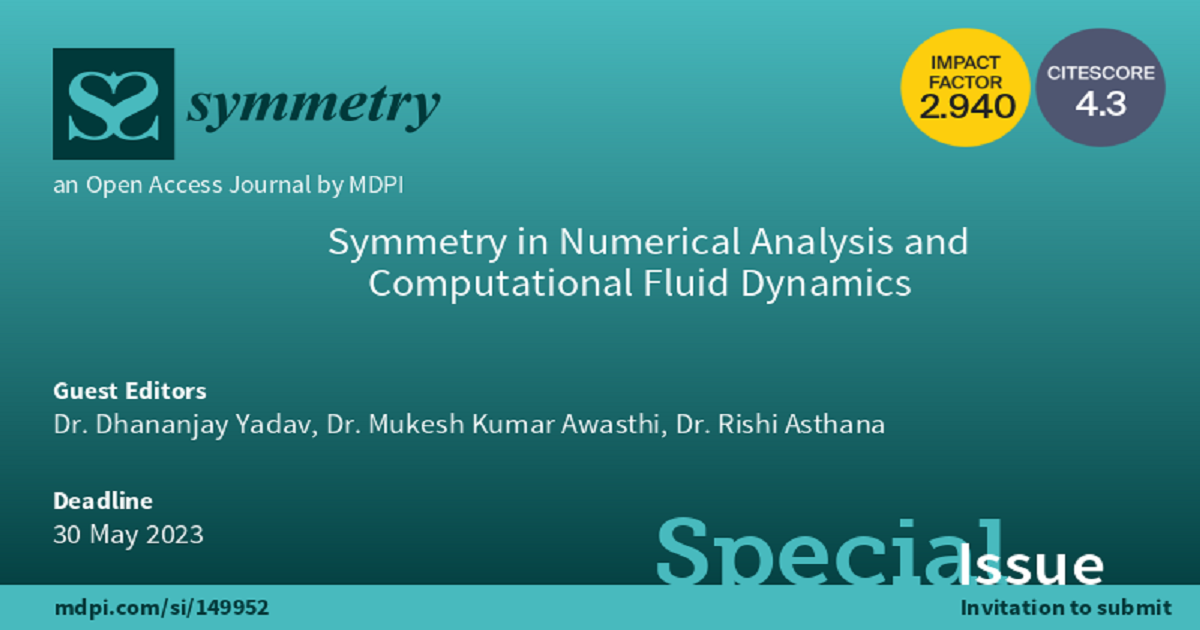Symmetry in Numerical Analysis and Computational Fluid Dynamics
A special issue of Symmetry (ISSN 2073-8994). This special issue belongs to the section "Mathematics".
Deadline for manuscript submissions: closed (31 October 2023) | Viewed by 15049

Special Issue Editors
Interests: carbon capture; storage and oil recovery; computational sustainability and environmental analytics; fluid mechanics; numerical analysis; hydrodynamic and hydromagnetic stability; nanofluids and fluid flow in porous media
Interests: viscous potential flow; fluid mechanics; heat and mass transfer; hydrodynamic stability; numerical analysis
Special Issue Information
Dear Colleagues,
Fluid flow, in various geometries, plays an important role in industry as well in our our daily life. In the case of cylindrical configuration, there are many applications of capillaries, such as water jets, film boiling, film-wise condensate, etc. The decay of any liquid cylindrical jet into different droplets is a complex and universal process that is useful both in nature and industry. The root cause of jet decay is the instability generated on the surface of the jet. When a liquid jet enters the atmosphere, the interface between the atmospheric air and the jet becomes unstable, resulting in liquid jet decay. The exact solution of the Navier–Stokes equation is not currently known, and therefore, general numerical- and symmetry-based numerical methods are very helpful for the computation of various properties of fluid flows required for industry.
The proposed Issue, “Symmetry in Numerical Analysis and Computational Fluid Dynamics”, will address the current developments in mathematical modeling and computations using general and symmetry-based numerical methods of various fluid phenomena arising in the biological, medical, and engineering sciences.
This issue will provide a comprehensive insight into the symmetrical and computational approaches to examine important emerging problems in the fields of fluid dynamics, including but not limited to:
- Onset of convection;
- Flow through porous media;
- Characteristics of nanofluid flow;
- Fluid–fluid interaction;
- Fluid–solid interaction;
- Instability arising in fluid flow;
- Boundary layer theory;
- Computational approaches;
- Numerical techniques;
- Flow through complex geometries;
- Impact of complex fluids;
- Symmetry and sensitivity analysis of fluid flows.
We invite contributions from authors on these topics.
Dr. Dhananjay Yadav
Dr. Mukesh Kumar Awasthi
Dr. Rishi Asthana
Guest Editors
Manuscript Submission Information
Manuscripts should be submitted online at www.mdpi.com by registering and logging in to this website. Once you are registered, click here to go to the submission form. Manuscripts can be submitted until the deadline. All submissions that pass pre-check are peer-reviewed. Accepted papers will be published continuously in the journal (as soon as accepted) and will be listed together on the special issue website. Research articles, review articles as well as short communications are invited. For planned papers, a title and short abstract (about 100 words) can be sent to the Editorial Office for announcement on this website.
Submitted manuscripts should not have been published previously, nor be under consideration for publication elsewhere (except conference proceedings papers). All manuscripts are thoroughly refereed through a single-blind peer-review process. A guide for authors and other relevant information for submission of manuscripts is available on the Instructions for Authors page. Symmetry is an international peer-reviewed open access monthly journal published by MDPI.
Please visit the Instructions for Authors page before submitting a manuscript. The Article Processing Charge (APC) for publication in this open access journal is 2400 CHF (Swiss Francs). Submitted papers should be well formatted and use good English. Authors may use MDPI's English editing service prior to publication or during author revisions.
Keywords
- flow through complex geometries
- complex fluid-flow and heat-transfer problems
- flow through porous media
- CFD theory and applications
- numerical methods
- symmetry analysis
Benefits of Publishing in a Special Issue
- Ease of navigation: Grouping papers by topic helps scholars navigate broad scope journals more efficiently.
- Greater discoverability: Special Issues support the reach and impact of scientific research. Articles in Special Issues are more discoverable and cited more frequently.
- Expansion of research network: Special Issues facilitate connections among authors, fostering scientific collaborations.
- External promotion: Articles in Special Issues are often promoted through the journal's social media, increasing their visibility.
- e-Book format: Special Issues with more than 10 articles can be published as dedicated e-books, ensuring wide and rapid dissemination.
Further information on MDPI's Special Issue policies can be found here.







